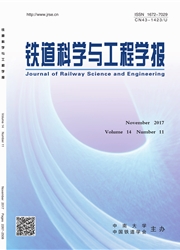

 中文摘要:
中文摘要:
连续道床板在降温和自身收缩情况下容易出现裂缝,从而造成伸缩刚度的折减,不同裂缝间距时的伸缩刚度差别很大,而伸缩刚度又是连续道床板温度力计算的重要参数。考虑钢筋与混凝土间的黏结滑移关系,建立一种连续道床板伸缩刚度计算方法,对不同裂缝间距情况下的钢筋和混凝土应力、黏结阻力以及伸缩刚度进行研究,对黏结阻力型式、混凝土强度等级和配筋率对伸缩刚度的影响进行参数研究。研究结果表明:即使在一定的裂缝间距情况下,伸缩刚度也并非一定值,而是随荷载增大而逐渐降低的变量,混凝土强度等级对伸缩刚度折减的影响较小,配筋率影响较大,检算过程中可根据裂缝间距增加一定的边界条件即可得到不同温度条件下的应力与刚度分布。
 英文摘要:
英文摘要:
Cracks will occur in the continuous track slab when temperature drops and concrete shrinks, which will induce a reduction of the longitudinal stiffness. Different crack spacing can lead to a big difference in longi- tudinal stiffness. Meanwhile the longitudinal stiffness is a very important parameter for determining the thermal stress in continuous track slab. In this paper, a calculation method about longitudinal stiffness of continuous track slab was established considering the bond slip relationship between concrete and rebar. The stress distribution of concrete and rebar, bonding resistance and longitudinal stiffness were calculated using this method. The influence of the bond slip relationship, concrete grade and reinforcement ratio to the reduction of the longitudinal stiffness were studied. The results show that even at a certain crack spacing the longitudinal stiffness is not a constant, but tends to decrease with the larger tension load. The concrete grade has little influence on the reduction of longitudinal stiffness, while the reinforcement ratio has great impact. In the process of checking calculation, a proper boundary condition should be added to get a stress and stiffness distribution under different crack spacing and temperature conditions.
 同期刊论文项目
同期刊论文项目
 同项目期刊论文
同项目期刊论文
 期刊信息
期刊信息
